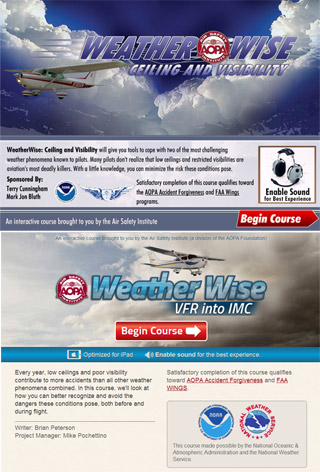Membership News & Notes: Saving SMO
Residents fight City Hall for control of Santa Monica Airport

A group of Santa Monica residents has launched a ballot initiative that would give city residents a say in the future use of Santa Monica Municipal Airport property, and AOPA has pledged to support the effort.
The group is proposing an amendment to the city charter that would require voter approval before the city can redevelop airport land. Surveys have consistently shown that the majority of Santa Monica residents want to keep the airport open.
Now the initiative advocates have launched a new website, making it easy for those who want to preserve Santa Monica Municipal Airport to show their support and stay informed on the initiative effort.
The Santa Monica Voters Decide website answers common questions about the amendment, provides the text of the proposal, and allows visitors to register their support and make financial contributions to the amendment campaign.
AOPA has been heavily engaged in efforts to preserve the airport, which delivers some $250 million in annual economic impact, hosts 175 businesses, and is responsible for 1,500 jobs in the city. The field also serves as a vital general aviation reliever airport in the congested Los Angeles basin. The fate of the airport has broader significance as well. More than 200 airports nationwide operate under similar agreements with the federal government. If Santa Monica is allowed to disregard its obligations and close the airport, other fields could suffer a similar fate.
SMO Timeline
1979: Santa Monica City Council votes to ban jets larger than Category B-II from the airport, resulting in the 1984 settlement of a federal lawsuit with the SMAA, AOPA, FAA, and others. As part of the settlement, the city agrees to keep the airport open and accessible through 2015.
2008: The Santa Monica City Council passes an ordinance banning Category C and D jets. The FAA says the move is outside the city’s authority, and issues a cease and desist order. U.S. District Court issues a temporary restraining order to prevent the city from enforcing the jet ban. The city appeals the order, and the U.S. District Court in Los Angeles upholds the FAA, a decision later sustained by the U.S. 9th Circuit Court of Appeals.
2009: The FAA holds a Part 16 hearing on the city ordinance, resulting in a ruling that the city’s ban on Category C and D aircraft violates the Surplus Property Act and FAA grant assurances. The ruling is later upheld by the FAA associate administrator, the U.S. District Court, and the U.S. Circuit Court of Appeals. AOPA filed an amicus curiae brief and participated in arguments before the Court of Appeals.
2011: Santa Monica launches visioning project to discuss the future of SMO as something other than an airport.
2013: City commissions and agencies begin discussions of ending fuel sales and not renewing aviation leases. City files federal lawsuit against the FAA to seek control of airport property over opposition by AOPA.
2014: AOPA files an amicus brief in the city lawsuit on airport land control; U.S. District Court dismisses case; city announces plans to appeal. City residents set ballot initiative.
NOTICE OF ANNUAL MEETING OF MEMBERS. The annual meeting of the members of the Aircraft Owners and Pilots Association will be held at 12 noon on Friday, September 5, 2014, at the headquarters of AOPA, 421 Aviation Way, Frederick, Maryland, 21701, located on the Frederick Municipal Airport (FDK), for the purpose of receiving reports and transacting such other business as may properly come before the meeting, specifically including the election of trustees.
AOPA Action: Collaboration works
Superior AMOC gets grounded aircraft flying
 Aircraft that have been grounded by an airworthiness directive (AD) affecting some Superior Air Parts replacement cylinder assemblies can get back in the air thanks to an alternative means of compliance (AMOC) approved by the FAA in May.
Aircraft that have been grounded by an airworthiness directive (AD) affecting some Superior Air Parts replacement cylinder assemblies can get back in the air thanks to an alternative means of compliance (AMOC) approved by the FAA in May.
The alternative means of compliance is the result of collaboration between Superior Air Parts, AOPA, and the FAA. It extends the replacement interval from 12 years to 17 years’ time in service for affected cylinders. In keeping with the original AD, cylinders must be replaced at engine-hour TBO and compression checks are required every 50 hours on cylinder assemblies with more than 750 flight hours. In addition, affected engines will require a visual inspection of the cylinder exterior and borescope inspection of the cylinder interior for corrosion as well as a warm-engine soapy-water-leak test every 50 hours.
Affected owners must notify their local flight standards district office of their intent to comply with the AD using the alternative means of compliance before taking action. The alternative means of compliance includes a sample notification letter to simplify the process for owners.
“Everyone concerned wanted to get grounded aircraft safely flying as quickly as possible, and we appreciate the hard work of Superior and the FAA to make this happen,” said Rob Hackman, AOPA vice president of regulatory affairs, who worked closely with both groups to develop an acceptable means of compliance.
The AD that grounded aircraft with certain Continental Motors engines took effect April 25. It was first issued in 2009 and reissued in March to address FAA concerns of “separation of the cylinder head, damage to the engine, and damage to the airplane.” Affected engines include Continental Motors IO-520, TSIO-520, and IO-550 engines—and any other engine, such as the 470 series, that has a supplemental type certificate for the same cylinder assemblies as the 520 and 550 series. The AD lists the Superior Air Parts part numbers that are affected.
Airport support network: A model ASN volunteer
One of the enjoyable parts of being an AOPA regional manager is connecting with Airport Support Network volunteers at their airports. At a recent barbeque fly-in, AOPA Southwest Regional Manger Yasmina Platt met Harry Peck, who has served as the ASN volunteer at Fayette Regional Air Center (3T5) in La Grange, Texas, since 2001.
On meeting Peck, Platt said she instantly realized what a wonderful advocate for general aviation he is, stating, “everybody there adores him”—exemplified by the work he does introducing new people to aviation. Peck is also a CFI, and during the fly-in a few of his high school student pilots joined the festivities. Platt noted that Peck was supportive and involved with them throughout the day.
Educating and training future pilots is Peck’s passion. It also is an important part of advocacy—introducing and creating an interest in general aviation for the future. If our national system of airports is to remain healthy and vibrant, it will be thanks to pilots like Harry Peck. Not only is Peck dedicated to instructing, but he has worked with AOPA on security issues, and enjoys a strong relationship with the airport manager.
When ASN volunteers are well known and well-respected by the flying community they serve, it is a wonderful partnership for AOPA and our members. Do you have these types of relationship with your pilot community? If so, that would make you an excellent ASN volunteer.
Member Services: Blood pressure refresher
Tips for an aging population
 AOPA’s medical certification staff routinely deal with all types of questions from our members regarding medical conditions that affect certification. Consistently at the top of the list over the years is high blood pressure. What’s interesting is the level of concern pilots have that their medical certificate will be in jeopardy once they start taking medications. In many cases, that fear of losing their medical may actually be contributing, in part, to their blood pressure problem.
AOPA’s medical certification staff routinely deal with all types of questions from our members regarding medical conditions that affect certification. Consistently at the top of the list over the years is high blood pressure. What’s interesting is the level of concern pilots have that their medical certificate will be in jeopardy once they start taking medications. In many cases, that fear of losing their medical may actually be contributing, in part, to their blood pressure problem.
There is no evidence that identifies hypertension as a causual factor in any aviation accident on record. That notwithstanding, the FAA still requires that we document that the blood pressure is controlled to the government’s satisfaction.
Adequately controlled hypertension is probably the simplest medical certification issue there is to take care of. In fact, the FAA last year further simplified the process by eliminating the need for an electrocardiogram and laboratory blood work. Now, there is a simple worksheet that requires basic information from your treating doctor that you will provide to your aviation medical examiner at the time of your next FAA physical examination. If the worksheet indicates appropriate medication therapy and good control, the AME will issue your medical certificate to you at the time of the examination. For each subsequent medical renewal, the process will be the same, so as long as you are on no more than three blood pressure meds, and your maximum blood pressure does not exceed 155/95 (a high maximum, by the way—but this is regulatory medicine, not clinical medicine) you will have no problems maintaining your medical.
If you have any questions about medical certification, give us a call (800-872-2672).
Gary Crump, AOPA’s director of medical certification, is a former operating room technician and emergency medical technician who has been assisting AOPA members for more than 25 years. He’s also a medical expert for AOPA’s Pilot Protection Services and has been flying since 1973.
Web: www.aopa.org/pps
AOPA and Jeppesen announce new partnership
AOPA and Jeppesen, the renowned aviation services company, announced a new corporate premier partnership that will support many of the programs offered to educate and engage AOPA pilot members across the country. Jeppesen’s partnership will include support and participation in AOPA Foundation Air Safety Institute seminars, the 2014 regional AOPA Fly-Ins, and the association’s seventy-fifth anniversary “Homecoming” Fly-In at its Frederick, Maryland, headquarters
“Jeppesen has played a pioneering role in providing pilot services and that innovation continues today,” said Mark Baker, AOPA president and CEO. “Supporting pilots and aircraft owners is a fundamental mission of both organizations, and we’re thrilled to have Jeppesen as a partner in our efforts to grow and serve the pilot community.”
The AOPA Corporate Partnership program helps fund AOPA’s core mission: Protecting the freedom to fly. AOPA members will benefit from Jeppesen’s support through AOPA Air Safety Institute seminars, which qualify as the ground portion of the FAA Wings program.
Under the new Jeppesen partnership, AOPA members who purchase a one-year subscription to JeppView with Mobile FliteDeck by June 30 will receive three additional months of service free. The service includes two or four installations so members can install JeppView on a PC and download Mobile FliteDeck at no extra cost. Plus members will receive access to MyFlitePlan Online for all flight planning needs. To sign up, call Jeppesen Customer Service at 800-964-6081 and reference offer code “AOPAPP.” Offer expires June 30, 2014.
AOPA Foundation
Safe pilots are always learning, and the Air Safety Institute’s goal is to ensure pilots have a wealth of information to keep flying safely. Our aviation safety educational programs are funded through donations from pilots dedicated to forwarding that mission. Show your support by donating to the AOPA Foundation today (www.aopafoundation.org/donate).
Attending EAA Air Venture this year?
Mark your calendar for these ASI safety seminars:
Thursday, July 31: Accident Case Study—Live (Part 1)
Friday, August 1: Accident Case Study—Live (Part 2)
Saturday, August 2: Weather Challenge
Fly with ASI and increase your safety IQ
Have you visited the Air Safety Institute’s new homepage? The intuitive layout makes it easier than ever to select aviation safety material of interest to you—learn online, take safety to go, read publications, renew your flight instructor certificate, check transcripts, and reprint certificates. Go to the website (www.airsafetyinstitute.org) and explore the wealth of free information ASI has to offer, so you can hone your skills, prepare for a flight review, and be an all-around safe and proficient pilot.
 Accident Case Study—Live
Accident Case Study—Live
Working with several compelling real-life cases, this seminar presenter and audience play the role of accident investigator—starting at the crash scene and working backward through physical evidence, eyewitness testimony, and other leads to figure out exactly what went wrong, and why.
Weather Challenge
We can bolster our real-world weather wisdom—and have a little fun, too. Take the opportunity to put your weather knowledge to the test from Metar/TAF decoding to real-world weather scenarios. Along the way you’ll learn about important weather resources and the promise (and pitfalls) of cockpit weather. The seminar also covers critical risk management and decision making as it delves into weather-related accidents that didn’t need to happen.
The weather is what you get
The Air Safety Institute recently joined the FAA and more than a dozen general aviation stakeholders for the FAA’s safety campaign, “Got Weather?” which features resources on a new weather topic each month through December 2014 (www.faa.gov/about/initiatives/got_weather). The campaign covers a broad range of weather phenomena that especially impact aviation—from thunderstorms to VFR flight into IMC to icing to crosswinds—and provides weather facts and links to videos, safety seminars, quizzes, proficiency programs, online training, case studies, and more. July’s focus is on IFR weather, and one of the best ways to understand weather phenomena leading up to instrument meteorological conditions and how it might impact you is to take ASI’s online courses on this topic. Two great courses, Weather Wise: Ceiling and Visibility (www.airsafetyinstitute.org/wxwise_ceilingvis) and Weather Wise: VFR into IMC (www.airsafetyinstitute.org/wxwise_vfrintoimc), cover important facts to help you recognize how unanticipated IFR conditions may adversely impact your flight. Also, take a moment to watch Accident Case Study: VFR into IMC (www.airsafetyinstitute.org/acs_vfrimc), to learn what happens when a pilot does not heed the warnings of low ceilings and visibility. Whether you’re a VFR-only pilot or have an instrument rating, these courses explore how to not fall prey to continued VFR flight into IMC, which is the leading cause of spatial disorientation—one of aviation’s top killers. Learn about critical rules to obey when clouds and Mother Earth begin to touch, and temperature and dew point converge.
Insurance Services: Renter’s insurance
A two-minute course in nonowner’s insurance
Buying renter’s insurance doesn’t have to be complicated, but it helps to understand the insurance lingo and what it means to you. The first and most important part of the policy is liability. This is your protection for passengers that you may injure and for who and what you hit. In insurance lingo this is your bodily injury and property damage liability. Under the AIG policy this is termed required coverage. The insurance company requires that you carry some limit of this protection before they will permit other coverage. This required coverage does not cover damage to the rented aircraft.
Your protection for the damage that you might do to a rented aircraft is called nonowned physical damage insurance or, under the AIG policy, optional coverage. It is this important opMtional coverage that would pay your insurance deductible, loss of use (lost profits) by the fight school, parts and labor required for engine teardowns and inspection, repair of the engine and aircraft to return it to the same condition as before the incident including test flights and pilot charges, and the reduced value of the aircraft (as now, because of this accident, it has a value reducing prior-loss history).
Most insurers recommend that you protect yourself with either the highest amount of required coverage you can afford and that is made available, or at a limit sufficient to give you the peace of mind you seek. The amount of optional coverage you need depends on the estimated value of the aircraft you typically fly as well as your rental agreement and what that rental agreement says you are responsible for.
As an example, let’s say you make an emergency landing in your rented airplane on a golf course and, while landing, you tear up the golf course, clip a golfer and your passenger suffers a neck injury. Required coverage covers the damage to the course and the golfer up to amount of chosen coverage, with your passenger’s injuries covered up to the per passenger sub-limit amount. Your optional coverage covers damage to the rented airplane. So if you had a $1 million policy with a per passenger sub-limit of $100,000 and optional coverage of $80,000: treatment of your passenger would be limited to $100,000. The remaining $900,000 could be used to cover damage to the golf course and medical care of the golfer. The $80,000 optional coverage would be your protection should you be liable for damage to the rented airplane.
Bill Snead is an aviation insurance professional with more than 35 years of experience.
Visit the website to learn about upgrading to the AOPA Premier membership.
AOPA Insurance Services is available to answer all your questions and help you make a decision that is right for your needs. AOPA Insurance Services is celebrating 20 years of serving the aviation insurance needs of our customers. Visit us online or call 800-622-2672 for information on how AOPA Insurance Services can help you get the best coverage at the very best price.


